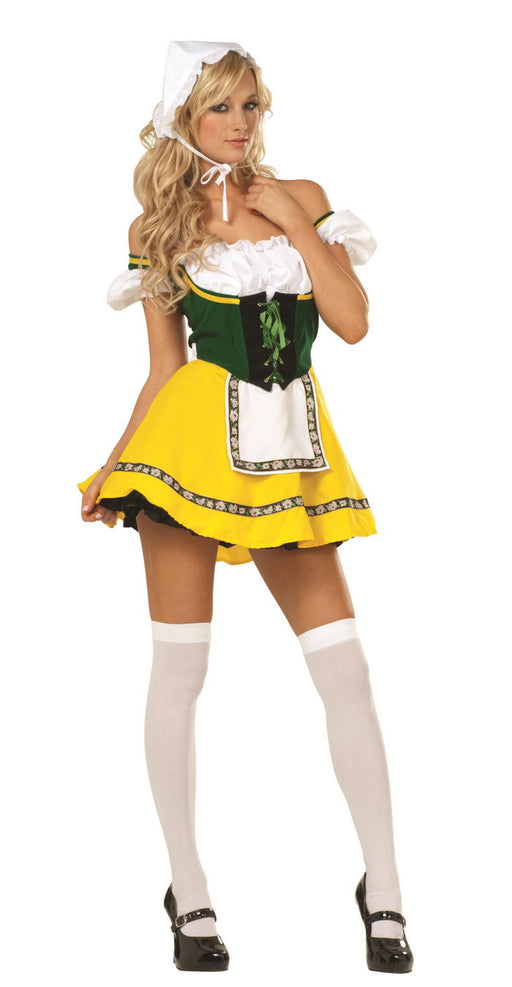
Preparing Your Squad for October's High-Pressure Games
October is a crucial month in the world of high school and college sports, with major games, homecoming events, and playoff matches filling the calendar. For cheerleading squads, this is one of the most important times of the year. The energy, excitement, and high stakes of these games mean that cheerleaders need to be at the top of their game, both in terms of skills and spirit. Proper preparation is essential to ensure that cheerleading squads can maintain high energy, enthusiasm, and performance levels during these intense events.
In this blog, we’ll explore the key steps cheerleading squads can take to prepare for October’s high-pressure games, from physical conditioning and choreography to mental toughness and team unity.
1. Physical Conditioning: Building Stamina and Strength
Cheerleading is an athletic endeavor that requires significant physical stamina, strength, and flexibility. As October’s big games approach, it’s important for squads to focus on conditioning to ensure they can perform at their best throughout the entire game.
Strength Training: Cheerleaders need strength for stunts, lifts, and tumbling routines. Incorporating regular strength training exercises, such as squats, lunges, and core workouts, can help build the muscles necessary for safe and effective stunts. Weight training and resistance band exercises are also great ways to build upper body and core strength, which are essential for flyer stability and base support.
Cardio Conditioning: Cheerleaders must be able to maintain energy levels throughout the entire game, from pre-game cheers to post-game celebrations. Incorporating cardio exercises such as running, jumping rope, or circuit training into practice routines will help build stamina. High-intensity interval training (HIIT) can also improve endurance, allowing cheerleaders to keep their energy high even during the most intense moments of the game.
Flexibility Training: Flexibility is key for executing high-level jumps, stunts, and tumbling passes. Regular stretching routines, including dynamic stretches before practice and static stretches afterward, can help improve flexibility and prevent injuries. Yoga and pilates are also excellent for enhancing both flexibility and core strength.
2. Perfecting Choreography: Crisp Routines for Maximum Impact
A cheer squad’s performance is only as good as its routines. With October games attracting large crowds, including alumni, parents, and community members, it’s important that cheerleaders deliver sharp, well-executed routines that captivate the audience and boost the team’s morale.
Routine Structure: The key to creating engaging cheer routines is variety. Teams should incorporate a mix of cheers, chants, stunts, jumps, and tumbling passes to keep the audience entertained. For homecoming or playoff games, consider creating special routines that reflect the significance of the event, such as including school traditions, mascots, or themed chants.
Timing and Precision: Clean, synchronized movements are essential for a polished performance. Cheerleaders should practice their routines regularly, focusing on timing and coordination. Coaches can use video recordings to review routines and identify areas where the squad can improve synchronization or sharpness.
Tumbling and Stunt Safety: Stunts and tumbling passes are crowd favorites, but they also carry a higher risk of injury. Ensuring that all stunts are safe and properly executed is critical, especially in high-pressure situations. Coaches should emphasize proper technique and spotting to prevent accidents. It’s also important to perform a risk assessment before introducing new stunts and to only include moves that the team has mastered.
3. Mental Preparation: Staying Focused Under Pressure
October games can be nerve-wracking for athletes, and cheerleaders are no exception. High-stakes games often come with large crowds, media coverage, and intense pressure to perform. Preparing the squad mentally is just as important as physical conditioning.
Visualization Techniques: Mental imagery is a powerful tool for building confidence and focus. Encourage cheerleaders to visualize themselves successfully performing their routines, hitting stunts, and leading the crowd in cheers. This practice helps reduce performance anxiety and boosts confidence.
Mindfulness and Relaxation: Incorporating mindfulness techniques such as deep breathing, meditation, or progressive muscle relaxation can help cheerleaders manage stress before and during the game. These exercises can calm nerves, improve focus, and promote a sense of control in high-pressure situations.
Positive Team Culture: Fostering a supportive and positive team environment is key to keeping morale high. Encourage team members to uplift and motivate each other, especially during challenging practices or tough game days. Building a sense of unity and trust within the squad will help cheerleaders feel more confident and supported as they take on the demands of October’s big events.
4. Team Building: Strengthening Unity and Communication
A successful cheerleading squad operates as a cohesive unit, with each member playing a critical role in achieving the team's goals. Strengthening team unity and communication is essential, especially as the pressure builds leading into October’s high-stakes games.
Team-Building Exercises: Incorporating team-building activities into practice can help build stronger relationships and improve communication between squad members. These activities can range from trust exercises and problem-solving games to off-the-field bonding events like team dinners or outings. The closer the team, the better they’ll perform together under pressure.
Communication and Leadership: Clear communication is essential for cheerleading, especially during stunts and formations. Coaches should emphasize the importance of effective communication between bases, flyers, and spotters. Captains and leaders can play a key role in fostering open dialogue and ensuring that every member feels heard and supported.
Goal Setting: Setting both individual and team goals can help keep the squad focused and motivated. These goals can range from mastering a specific stunt or routine to maintaining energy throughout the game. Celebrating small victories along the way helps build momentum and boosts team confidence heading into October’s biggest games.
5. Crowd Engagement: Leading the School Spirit
A major part of a cheerleading squad’s role is to energize the crowd and build excitement for the team. Cheerleaders act as the driving force behind school spirit, and in October’s high-pressure games, their ability to engage the crowd can have a big impact on the atmosphere and even the team’s performance.
Creating New Chants: To keep the crowd energized, cheerleaders should regularly introduce new chants or cheers. Themed chants for specific games, such as homecoming or rivalry matchups, can add extra excitement. Involving the crowd in interactive cheers where they repeat or respond to the squad is a great way to boost participation.
Using Signs and Props: Incorporating signs, pom-poms, and megaphones can help amplify cheers and make them more engaging for the audience. Signs with words or letters that spell out the team’s name or mascot can encourage the crowd to chant along with the squad. Cheerleaders can also use props to lead creative and exciting routines that break the monotony of repetitive cheers.
Involving the Band and Mascot: Collaborating with the school’s band and mascot can take crowd engagement to the next level. Coordinating cheers with the band’s music or having the mascot lead interactive games or challenges during halftime can keep the energy high and create memorable moments for the fans.
6. Preparing for Halftime Shows: The Big Moment
For many cheerleading squads, the halftime show is one of the biggest performances of the season. With the entire crowd’s attention focused on the field, it’s an opportunity for cheerleaders to showcase their skills and bring the house down.
Choreographing the Show: Halftime performances should be dynamic and visually engaging, combining stunts, pyramids, tumbling, and dance. The routine should build in intensity, with a climactic finish that leaves the crowd cheering. If possible, involve the band or other performance groups for a collaborative show that feels like a true celebration of school spirit.
Practicing in Game Conditions: Performing during halftime is different from practicing in a gym or on a practice field. The size of the stadium, the noise of the crowd, and the pressure of the moment can all affect performance. To prepare, squads should practice their routines in a similar environment, whether it’s on the actual field or in front of smaller groups to simulate game-day conditions.
Creating a Memorable Moment: Whether it’s a signature stunt, a crowd chant, or a surprise appearance by the mascot, cheerleaders should aim to create a memorable moment that stands out. This could involve incorporating a theme, using special props, or even inviting alumni cheerleaders or athletes to join in.
7. Maintaining Energy Throughout the Game
Cheerleaders are expected to keep the crowd energized for the duration of the game, from the first whistle to the final buzzer. Maintaining high energy levels, especially during long or intense games, requires planning and strategy.
Energy Management: Coaches should work with their squads to manage energy levels throughout the game. This may involve rotating cheerleaders during the game or giving them brief breaks during timeouts or halftime. Ensuring cheerleaders stay hydrated and fueled with snacks is also important for keeping energy levels up.
Staying Engaged During Down Moments: Not every moment of the game will be high-energy, and cheerleaders need to know how to keep the crowd engaged during slower parts of the game. Simple chants, clapping, or coordinating with the band can help maintain the crowd’s focus and enthusiasm.
8. Celebrating Success and Learning from Challenges
After the final whistle, it’s important to reflect on both the successes and the challenges faced during the game. Celebrating the squad’s hard work and accomplishments, whether they hit a difficult stunt or led a memorable cheer, helps build confidence and team unity.
Coaches should also use the time after games to provide constructive feedback and identify areas for improvement. This allows the squad to learn from each experience and continue to grow as a team as they move forward in the season.
Featured collection
Sexy Post Office Girl | Costume-Shop.com
Attention all aspiring letter carriers and mail enthusiasts! Prepare to deliver a package of seductive style and naughty charm with our Sexy Post O...
View full detailsNorthern Warrior Costume | Costume-Shop.com
Upgrade your costume game to legendary status with the Northern Warrior Costume! Designed for rugged adventurers and fearless warriors of the North...
View full detailsBeer Garden Babe Oktoberfest | Costume-shop.com
🇩🇪 Step into the Festivities with Bavarian Charm! Embrace the spirit of Oktoberfest in the Beer Garden Babe Costume from www.Costume-shop.com. Perf...
View full detailsSailor's Delight | Costume-Shop.com
🚢 Navigate the High Seas of Fashion! Command attention at your next party with the Sailor's Delight Costume from www.Costume-shop.com. Perfect for ...
View full detailsSexy Police Officer Hottie | Costume-Shop.com
🚓 Enforce Fun with a Dash of Flair! Step into the role of authority with the Sexy Police Officer Hottie Costume from www.Costume-shop.com. Designed...
View full details








Leave a comment